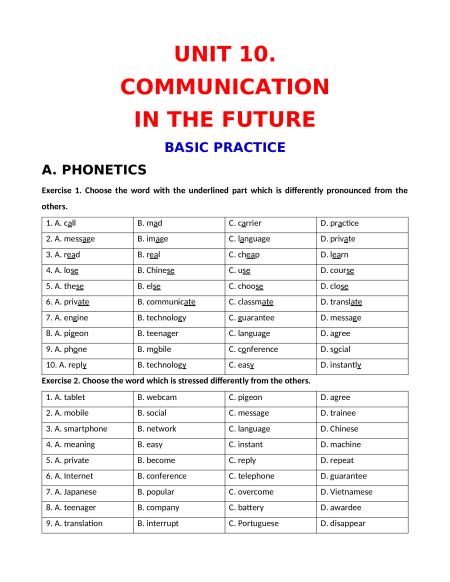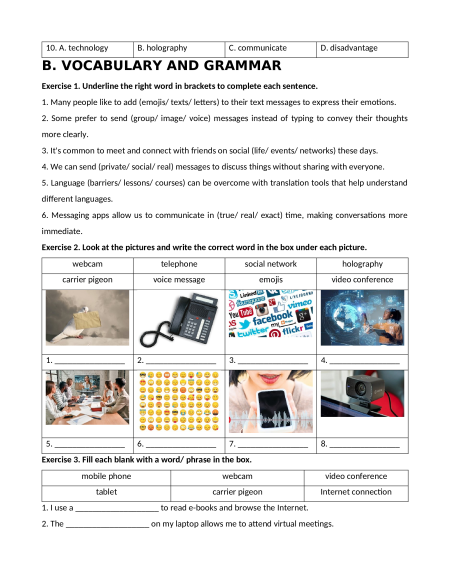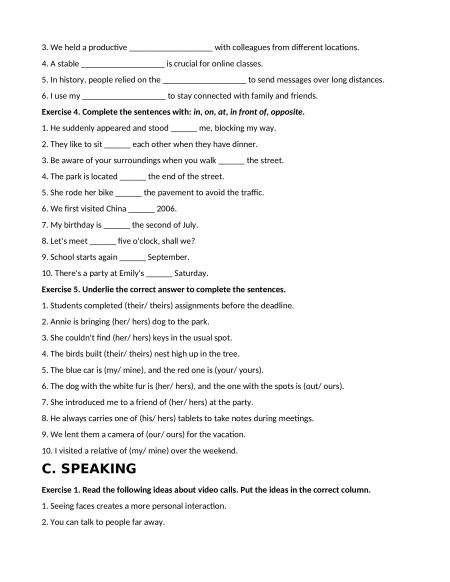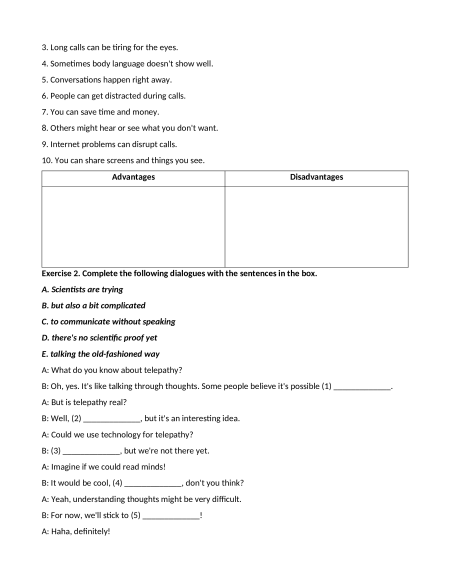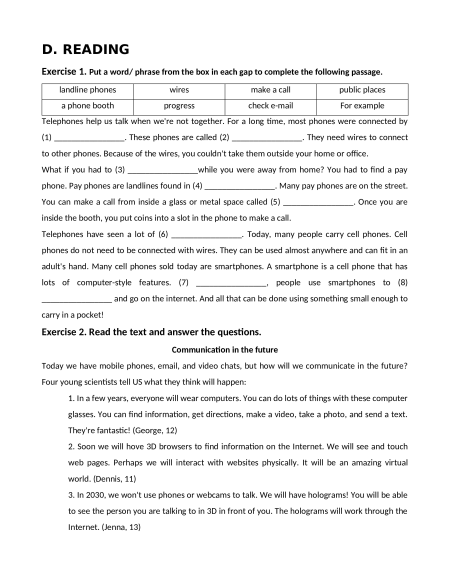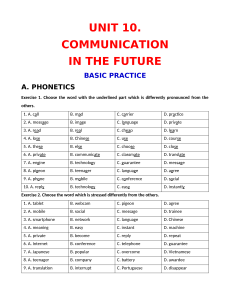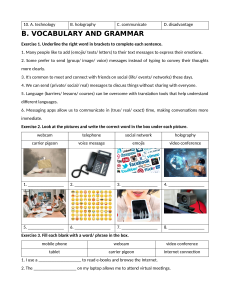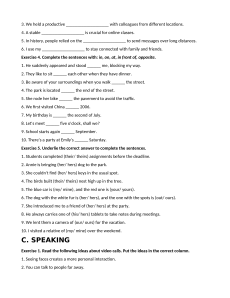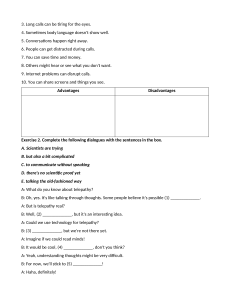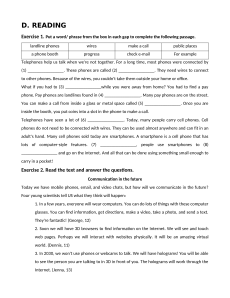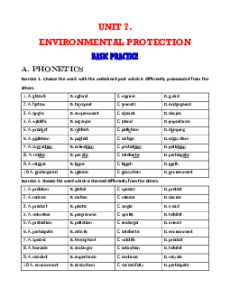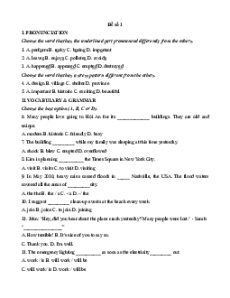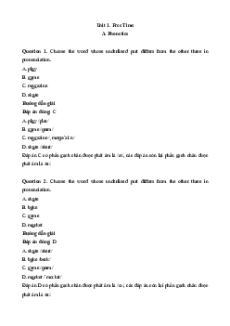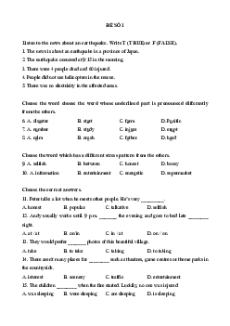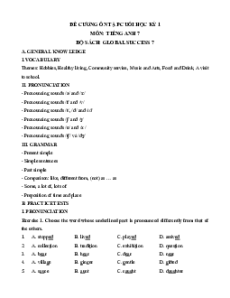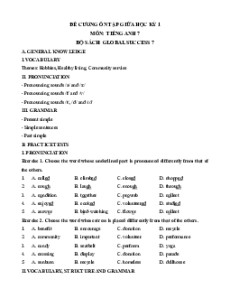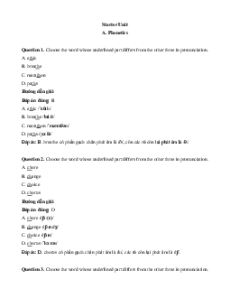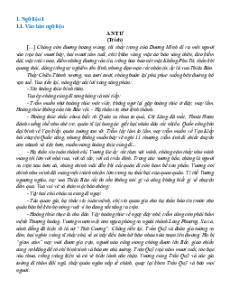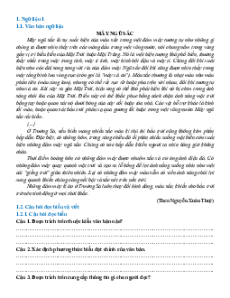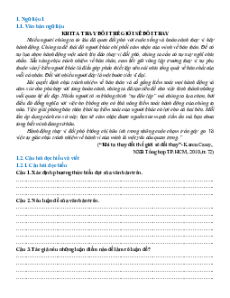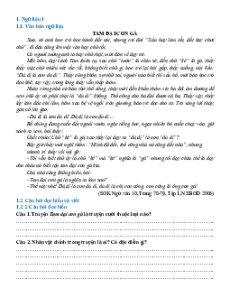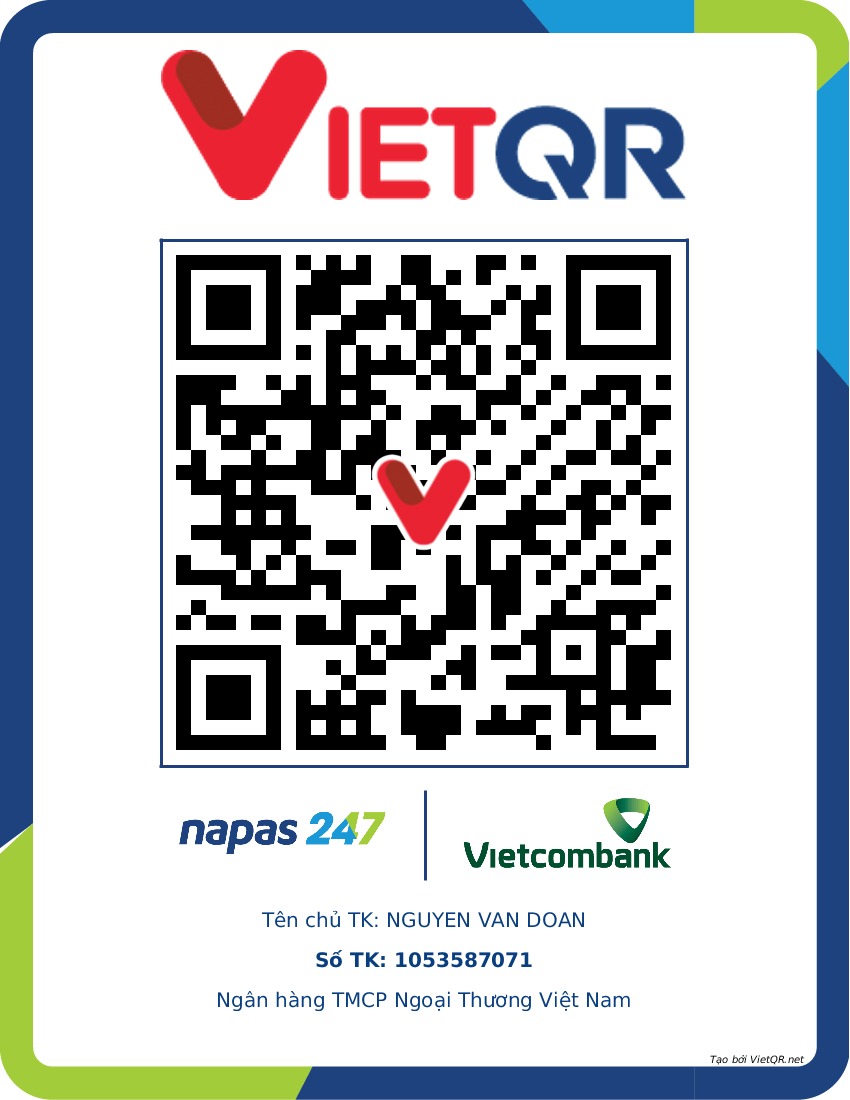UNIT 10. COMMUNICATION IN THE FUTURE BASIC PRACTICE A. PHONETICS
Exercise 1. Choose the word with the underlined part which is differently pronounced from the others. 1. A. call B. mad C. carrier D. practice 2. A. message B. image C. language D. private 3. A. read B. real C. cheap D. learn 4. A. lose B. Chinese C. use D. course 5. A. these B. else C. choose D. close 6. A. private B. communicate C. classmate D. translate 7. A. engine B. technology C. guarantee D. message 8. A. pigeon B. teenager C. language D. agree 9. A. phone B. mobile C. conference D. social 10. A. reply B. technology C. easy D. instantly
Exercise 2. Choose the word which is stressed differently from the others. 1. A. tablet B. webcam C. pigeon D. agree 2. A. mobile B. social C. message D. trainee 3. A. smartphone B. network C. language D. Chinese 4. A. meaning B. easy C. instant D. machine 5. A. private B. become C. reply D. repeat 6. A. Internet B. conference C. telephone D. guarantee 7. A. Japanese B. popular C. overcome D. Vietnamese 8. A. teenager B. company C. battery D. awardee 9. A. translation B. interrupt C. Portuguese D. disappear 10. A. technology B. holography C. communicate D. disadvantage B. VOCABULARY AND GRAMMAR
Exercise 1. Underline the right word in brackets to complete each sentence.
1. Many people like to add (emojis/ texts/ letters) to their text messages to express their emotions.
2. Some prefer to send (group/ image/ voice) messages instead of typing to convey their thoughts more clearly.
3. It's common to meet and connect with friends on social (life/ events/ networks) these days.
4. We can send (private/ social/ real) messages to discuss things without sharing with everyone.
5. Language (barriers/ lessons/ courses) can be overcome with translation tools that help understand different languages.
6. Messaging apps allow us to communicate in (true/ real/ exact) time, making conversations more immediate.
Exercise 2. Look at the pictures and write the correct word in the box under each picture. webcam telephone social network holography carrier pigeon voice message emojis video conference 1. ________________ 2. ________________ 3. ________________ 4. ________________ 5. ________________ 6. ________________ 7. ________________ 8. ________________
Exercise 3. Fill each blank with a word/ phrase in the box. mobile phone webcam video conference tablet carrier pigeon Internet connection
1. I use a ___________________ to read e-books and browse the Internet.
2. The ___________________ on my laptop allows me to attend virtual meetings.
3. We held a productive ___________________ with colleagues from different locations.
4. A stable ___________________ is crucial for online classes.
5. In history, people relied on the ___________________ to send messages over long distances.
6. I use my ___________________ to stay connected with family and friends.
Exercise 4. Complete the sentences with: in, on, at, in front of, opposite.
1. He suddenly appeared and stood ______ me, blocking my way.
2. They like to sit ______ each other when they have dinner.
3. Be aware of your surroundings when you walk ______ the street.
4. The park is located ______ the end of the street.
5. She rode her bike ______ the pavement to avoid the traffic.
6. We first visited China ______ 2006.
7. My birthday is ______ the second of July.
8. Let's meet ______ five o'clock, shall we?
9. School starts again ______ September.
10. There's a party at Emily's ______ Saturday.
Exercise 5. Underlie the correct answer to complete the sentences.
1. Students completed (their/ theirs) assignments before the deadline.
2. Annie is bringing (her/ hers) dog to the park.
3. She couldn't find (her/ hers) keys in the usual spot.
4. The birds built (their/ theirs) nest high up in the tree.
5. The blue car is (my/ mine), and the red one is (your/ yours).
6. The dog with the white fur is (her/ hers), and the one with the spots is (out/ ours).
7. She introduced me to a friend of (her/ hers) at the party.
8. He always carries one of (his/ hers) tablets to take notes during meetings.
9. We lent them a camera of (our/ ours) for the vacation.
10. I visited a relative of (my/ mine) over the weekend. C. SPEAKING
Exercise 1. Read the following ideas about video calls. Put the ideas in the correct column.
1. Seeing faces creates a more personal interaction.
2. You can talk to people far away.
3. Long calls can be tiring for the eyes.
4. Sometimes body language doesn't show well.
5. Conversations happen right away.
6. People can get distracted during calls.
7. You can save time and money.
8. Others might hear or see what you don't want.
9. Internet problems can disrupt calls.
10. You can share screens and things you see. Advantages Disadvantages
Exercise 2. Complete the following dialogues with the sentences in the box. A. Scientists are trying B. but also a bit complicated
C. to communicate without speaking
D. there's no scientific proof yet
E. talking the old-fashioned way
A: What do you know about telepathy?
B: Oh, yes. It's like talking through thoughts. Some people believe it's possible (1) _____________. A: But is telepathy real?
B: Well, (2) _____________, but it's an interesting idea.
A: Could we use technology for telepathy?
B: (3) _____________, but we're not there yet.
A: Imagine if we could read minds!
B: It would be cool, (4) _____________, don't you think?
A: Yeah, understanding thoughts might be very difficult.
B: For now, we'll stick to (5) _____________! A: Haha, definitely!
Bài tập bổ trợ nâng cao Unit 10: Communication in the future Tiếng Anh 8 Global success
2 K
1 K lượt tải
MUA NGAY ĐỂ XEM TOÀN BỘ TÀI LIỆU
CÁCH MUA:
- B1: Gửi phí vào TK:
1133836868- CT TNHH DAU TU VA DV GD VIETJACK - Ngân hàng MB (QR) - B2: Nhắn tin tới Zalo VietJack Official ( nhấn vào đây ) để xác nhận thanh toán và tải tài liệu - giáo án
Liên hệ ngay Hotline hỗ trợ: 084 283 45 85
Tài liệu được cập nhật liên tục trong gói này từ nay đến hết tháng 3/2024. Chúng tôi đảm bảo đủ số lượng đề đã cam kết hoặc có thể nhiều hơn, tất cả có BẢN WORD, LỜI GIẢI CHI TIẾT và tải về dễ dàng.
Để tải tài liệu gốc về máy bạn click vào nút Tải Xuống ở trên!
Thuộc bộ (mua theo bộ để tiết kiệm hơn):
- Tailieugiaovien.com.vn giới thiệu Bài tập bổ trợ nâng cao Tiếng Anh 8 Global success Kì 2 mới nhất nhằm giúp Giáo viên có thêm tài liệu tham khảo bài tập Tiếng Anh 8.
- File word có lời giải chi tiết 100%.
- Mua trọn bộ sẽ tiết kiệm hơn tải lẻ 50%.
Đánh giá
4.6 / 5(1995 )5
4
3
2
1
Trọng Bình
Tài liệu hay
Giúp ích cho tôi rất nhiều
Duy Trần
Tài liệu chuẩn
Rất thích tài liệu bên VJ soạn (bám sát chương trình dạy)
TÀI LIỆU BỘ BÁN CHẠY MÔN Tiếng Anh
Xem thêmTÀI LIỆU BỘ BÁN CHẠY Lớp 8
Xem thêmTài liệu bộ mới nhất

UNIT 10.
COMMUNICATION
IN THE FUTURE
BASIC PRACTICE
A. PHONETICS
Exercise 1. Choose the word with the underlined part which is dierently pronounced from the
others.
!
" # $
%
Exercise 2. Choose the word which is stressed dierently from the others.
# &#
#
&'
#
( $
) *
! #+ &
" ,

%
B. VOCABULARY AND GRAMMAR
Exercise 1. Underline the right word in brackets to complete each sentence.
- './010+211
3$.002$
(4&$.$00&'2
5.002&&
6.#002#&
7
-&.00128'
Exercise 2. Look at the pictures and write the correct word in the box under each picture.
&# &'
/ $
9999999999999999 9999999999999999 9999999999999999 9999999999999999
9999999999999999 9999999999999999 9999999999999999 !9999999999999999
Exercise 3. Fill each blank with a word/ phrase in the box.
# &# $
# (
(9999999999999999999:#'#&(
;9999999999999999999 &+
59999999999999999999&$7
#9999999999999999999$
( 89999999999999999999
( 9999999999999999999 &$ $
Exercise 4. Complete the sentences with:
< 9999998#' &
; '999999&
&$ & &'999999
;'999999$
3#'999999=
5>999999%%
- # 999999$)
!64999999>4'8&?
"39999993#
%;4 @ 49999993
Exercise 5. Underlie the correct answer to complete the sentences.
3.02#$
#.02'
34>.02'
;##.02
;#. 028. 0 2
;&&$.028&.02
3$$.02
!<& $.02#'
"5$.02$
%($. 02&'
C. SPEAKING
Exercise 1. Read the following ideas about video calls. Put the ideas in the correct column.
3$
A'$&

6#$
3# 4&&
&
,
A
!B& 4&
"(#
%A
Advantages Disadvantages
Exercise 2. Complete the following dialogues with the sentences in the box.
!"
C5 '&# ?
CB8 (4''3#4#.29999999999999
C ?
C58.299999999999998#4
C& $ ?
C.299999999999998#&4
C($&D
C(.2999999999999984 '?
CA8# =
CE&8&4'.29999999999999D
C<8> D

D. READING
Exercise 1. Put a word/ phrase from the box in each gap to complete the following passage.
& ' #
# ': E1
;'&&4E8&#
.29999999999999999;.29999999999999999; &
$&8 4' =
5$ .29999999999999999& && $?A>
, $.29999999999999999-
A'$.29999999999999999B
#8 '
;$.29999999999999999; 8
#&&; # &>
4-
$ : $ .2 99999999999999998 .!2
9999999999999999#
'D
Exercise 2. Read the text and answer the ques,ons.
Communica,on in the future
; ͸#&&&$?
E F3& '&C
($& 8 &&A$&
A>$88'8'81
; 4$D.G82
3&&#&>$(5&
&#,&&&&# (&#H
&.82
(%%8&&4&#'5&DA&##
'$$ ;&&'
(.)82
